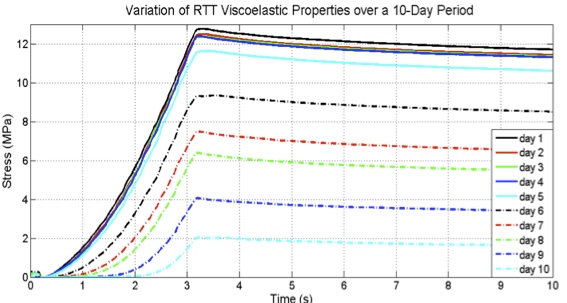制备鼠尾肌腱的生物力学和Mechanobiological研究
Summary
本文介绍了用于制备生物力学和mechanobiological研究大鼠尾腱的实验程序。表现出几个特点编制的主要步骤,开始提取,截面积的测量,清洗和加载到生物反应器室。
Abstract
鼠尾腱(RTT的)是一种常见的生物模型,用于在体外研究实验在肌腱的生理和肌腱领域。与这些组织的工作是具有挑战性的,因为他们是非常脆弱的,到现在为止,没有严格详细的协议,其隔离。
面对这些挑战,我们已经制定的方法和手段,以促进操纵RTT的和控制组织的可行性,不育和完整性。本文介绍了用于准备RTT的生物力学和mechanobiological研究的实验程序。我们的工作分为四个主要步骤:提取,截面积的测量,冲洗,并加载到生物反应器室。
在每一步中,所有程序,材料和操作详细介绍,使他们可以很容易地复制。此外,制定了具体的工具是:一个操纵板用于隔离RTT的,光纤微米的位置在截面积测量和锚固系统的组织到一个生物反应器的RTT的重视。
最后,我们描述了多个测试后获得的结果,来验证我们的方法。的可行性,不育性和完整性的评估表明,我们的程序十分脆弱的组织,如鼠尾肌腱操作严格。
Protocol
Discussion
通过应用这些实验程序,我们可以进行这样的组织在体外研究了多种。例如,组织变性的研究进行了为期10天的RTT的刺激下的应用程序。每一天,我们评估组织的力学性能,在非破坏性应力松弛试验。最后,我们能够观察到的RTT的应力变化,从而分析力学性能的进展。

图9。内河码头的应力变化评估槽松弛?…
Declarações
The authors have nothing to disclose.
Acknowledgements
本文NSERC格兰特#299280,IRSST作为本科学生研究奖为M. CYR的奖学金(七)家长和FRSQ的支持。我们感谢执行上的视频记录的操作Yoan Lemieux Laneville。
Materials
| Material Name | Tipo | Company | Catalogue Number | Comment |
|---|---|---|---|---|
| D-PBS | Reagent | Wisent inc. | 311-410-CL | Saline solution |
| Glucose | Reagent | Wisent inc. | 609-037-EL | Saline solution
1g/L |
| Antibiotics-antimycotics | Reagent | Invitrogen Corp. | 15240-062 | Saline solution
1% |
| DMEM | Reagent | Invitrogen Corp. | 12800-017 | Culture solution |
| Sodium Bicarbonate | Reagent | Wisent inc. | 600-105-CG | Culture solution 3.7g/L |
| FBS | Reagent | Wisent inc. | 090150 | Culture solution 10% |
| Antibiotics-antimycotics | Reagent | Invitrogen Corp. | 15240-062 | Culture solution 1% |
| Optic Micrometer | Tool | Custom-made | ||
| Manipulation plate | Tool | Custom-made | ||
| Bioreactor chamber | Tool | Custom-made |
Referências
- Bennett, M. B., Ker, R., Dimery, N., Alexander, R. Mechanical properties of various mammalian tendons. J. Zool. Lond. A209, 537-548 (1986).
- Dupuis, D. . Déshydratation de matrices collagéniques reconstruites in vitro: effets sur les propriétés mécaniques et histologiques [dissertation]. , 114-114 (1981).
- Haut, R. C. Age-dependent influence of strain rate on the tensile failure of rat tail tendon. Journal of Biomechanical Engineering. 105, 296-299 (1983).
- Huppé, N., Lessard, J. -. L., Langelier, E. A Bioreactor Design for the Mechanobiological Study of Soft Tissue Damage and Repair in Conditions that Provide the Best Approximation of Actual Use. , (1985).
- Langelier, E., Dupuis, D., Guillot, M., Goulet, F. &. a. m. p. ;. a. m. p., Rancourt, D. Cross-sectional profiles and volume reconstructions of soft tissues using laser beam measurements. J Biomech Eng. 126, 796-802 (2004).
- Lee, T. Q., Woo, S. L. -. Y. A new method for determining cross-sectional shape and area of soft tissues. J Biomech Eng. 110, 110-114 (1988).
- Parent, G., Cyr, M., Cousineau-Pelletier, P., Desbiens-Blais, F. &. a. m. p. ;. a. m. p., Langelier, E. Current Techniques for the Evaluation of Cross-Sectional Area in Rat Tail Tendons Generate Significant Errors. , (1985).

